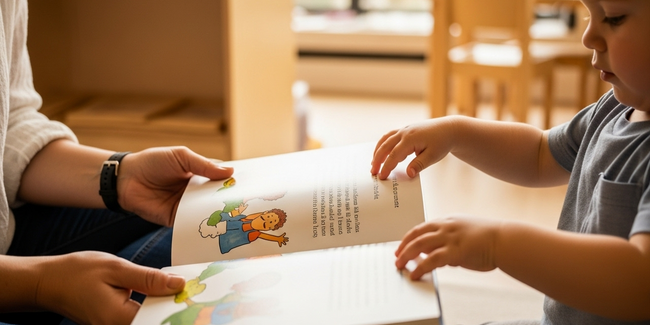Did you know that a staggering 90% of your child’s brain develops by the time they turn five? During these foundational years, every cuddle, every song, and every shared moment contributes to the person they are becoming. As early childhood experts on the Sunshine Coast, we’ve seen firsthand that one of the most powerful, loving, and profoundly effective tools you have to nurture this growth is one you already know: the simple act of telling a story.
But this is the guidance other centres often won’t give you. Storytelling is not just a pleasant way to pass the time or settle a child for sleep. It is a critical developmental process, a complex neurological workout disguised as a fairytale. It’s the ‘why’ behind the play.
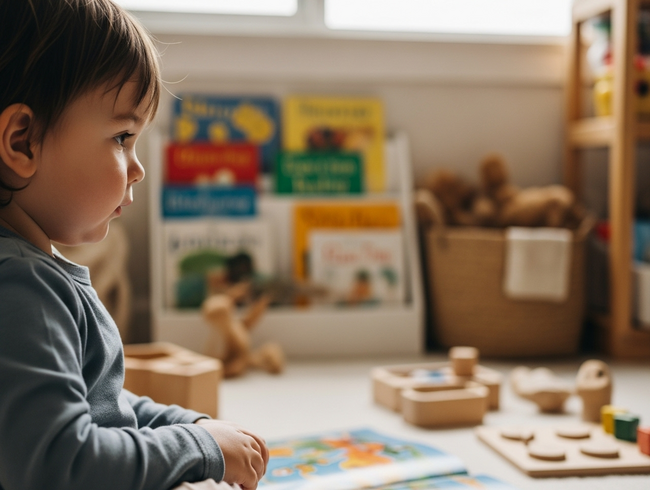
Deep concentration during story time shows the active neural development happening in your toddler’s growing brain.
This guide will demystify the science behind storytelling, moving beyond the what and into the how and why. We will explore the deep impact narratives have on your toddler’s developing brain and empower you with evidence-based techniques to foster their language, cognitive, and emotional growth. At Okinja Early Learning Centre & Kindergarten, our philosophy is built on understanding this science, and we believe every parent deserves to understand it too.
The Science Behind the Magic: How Stories Weave the Fabric of a Toddler’s Brain
When you open a book or begin a tale, you are doing far more than sharing words. You are inviting your child’s brain to perform an incredible series of tasks that build essential architecture for all future learning.
Every story—with its beginning, middle, and end—introduces the concept of sequence and consequence. This forges and strengthens neural pathways, the intricate communication networks within the brain. Think of it not as building a road, but as weaving a rich, complex tapestry. Each new character, plot twist, and emotion adds another thread, making the overall mental picture stronger, more detailed, and more interconnected. This process is the very foundation of logical reasoning.
Furthermore, storytelling is a primary vehicle for developing symbolic thinking—the cornerstone of all abstract thought. When a toddler understands that the drawing of a bear on a page represents a real bear, or that a simple wooden block can become a car in a make-believe story, their brain is making a monumental leap. They are learning that one thing can stand for another. This is the same cognitive skill they will later use to understand that the letter ‘A’ represents a sound and that the number ‘5’ represents a quantity.
The Developmental Symphony: The Broad Benefits of Storytelling
A consistent routine of storytelling orchestrates a symphony of developmental benefits, with each instrument playing a vital part in your child’s growth. Our approach, guided by the principles of the Early Years Learning Framework (EYLF), recognises how these elements work in harmony.
1. Language and Literacy Foundation (EYLF Outcome 5: Children are effective communicators)
Storytelling is the single most important activity for building a rich vocabulary and developing early literacy skills. When children hear stories, they are exposed to words and sentence structures they might not encounter in everyday conversation. They learn the rhythm and melody of language.
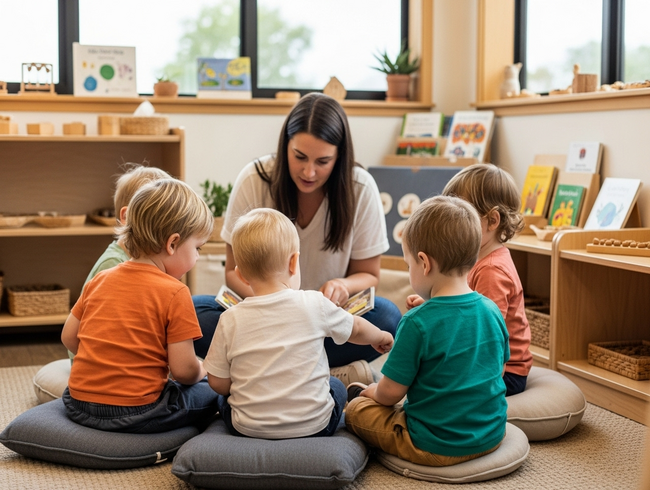
Group storytelling sessions provide rich opportunities for language development and social learning.
- Vocabulary Expansion: Stories introduce a universe of new words—’enormous’, ‘shimmering’, ‘brave’—in a context that makes them understandable.
- Narrative Skills: Children learn that stories have a structure. This understanding of sequence is a precursor to reading comprehension and coherent writing later in life.
- Phonological Awareness: The rhymes in a Dr. Seuss book or the alliteration in a simple poem tune a child’s ear to the sounds within words, a critical skill for learning to read.
The national framework is clear: for children to become effective communicators, they must “engage with a range of texts and gain meaning from these texts.” Storytelling is the most joyful and effective way to bring this outcome to life.
2. Cognitive Growth: Building a Mind That Can Focus, Remember, and Imagine
The mental effort required to follow a story is a powerful workout for a toddler’s cognitive functions.
- Concentration and Focus: In a world of fleeting digital distractions, the sustained attention required to listen to a story builds a child’s ability to concentrate for lengthening periods.
- Memory Development: Asking your child, “What do you think will happen next?” or “Do you remember who the Gruffalo met first?” encourages them to hold information in their minds, strengthening their working memory.
- Imagination and Creativity: Stories create worlds that don’t yet exist. They give children the raw material to build their own internal landscapes, fostering the creativity and problem-solving skills essential for innovation.
3. Social and Emotional Intelligence (NQS Quality Area 5: Relationships with Children)
Perhaps the most profound benefit of storytelling is its power to nurture emotional intelligence (EQ). A story is a safe laboratory for exploring complex human feelings.
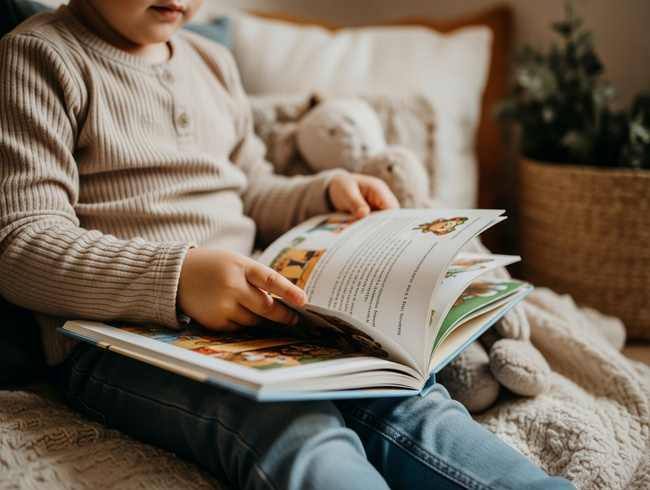
The gentle ritual of turning pages creates emotional security and connection during story time.
- Developing Empathy: By stepping into a character’s shoes, a child learns to consider another’s perspective. They can feel the Little Engine’s determination or the lost puppy’s sadness, building the foundations of compassion.
- Emotional Vocabulary: Stories give names to big feelings. When a character is ‘frustrated’, ‘excited’, or ‘disappointed’, it provides a toddler with the language to understand and express their own emotional world.
- Security and Connection: The ritual of storytime—the warmth of a lap, the focus of shared attention—is a powerful bonding experience. It reinforces a child’s sense of safety and belonging, which is central to building the secure, respectful, and reciprocal relationships outlined in the National Quality Standard.
Your Storytelling Toolkit: Age-Appropriate Techniques for Maximum Impact
Effective storytelling isn’t about performance; it’s about connection. How you share a story should adapt as your child grows.
For the Young Toddler (12-24 months)
At this stage, the experience is more sensory than narrative. Your goal is engagement, not comprehension of a complex plot.
- Use Your Voice: Vary your pitch and volume. Whisper the quiet parts and be more animated for the exciting moments. Animal sounds are always a hit!
- Choose Tactile Books: Board books with different textures, lift-the-flaps, and vibrant, simple illustrations are perfect. Let them touch, feel, and even chew on the book—it’s all part of the exploration.
- Repetition is Key: Reading the same book ten times in a row may test your patience, but it’s exactly what their brain needs. Repetition builds memory and predictability, which is deeply comforting.
For the Older Toddler (2-3 years)
Their attention spans are growing, and they can now follow a simple narrative. Your role shifts from performer to co-creator.
- Ask Open-Ended Questions: Pause and ask, “Why do you think he’s sad?” or “What should she do now?” This invites them into the story and develops critical thinking.
- Introduce Simple Props: Use a teddy bear to act out a scene or a blue scarf to represent a river. This helps bridge the gap between the abstract story and the concrete world.
- Let Them Lead: Encourage them to “read” a familiar book to you by telling the story from the pictures. It doesn’t matter if they get it “wrong”—they are practicing narrative skills and building confidence.
Weaving Stories into Your Day: Practical Strategies for Sunshine Coast Families
Integrating storytelling doesn’t have to be confined to a 10-minute slot at bedtime. A story can happen anywhere, at any time.
- Establish a Ritual: Consistency is powerful. A predictable storytime, whether after a bath or before a nap, creates a cherished moment of connection that children come to rely on.
- Embrace the Wiggles: It’s a myth that toddlers must sit perfectly still to be listening. If your child needs to move, try interactive stories that involve actions (“Let’s stomp like a dinosaur!”). Keep sessions short and engaging. Sometimes a two-minute story is more effective than a ten-minute battle.
- Go Beyond the Book: Tell stories from your own childhood. Make your toddler the hero of a simple tale (“Once upon a time, there was a brave explorer named Leo who went to the supermarket…”). This personal connection is incredibly powerful.
- Use the World as Your Library: The world around us is filled with stories. The universal principle of connecting narrative to real-world experiences solidifies learning. This is why our philosophy at Okinja Early Learning Centre & Kindergarten so deeply values our connection to nature. Our unique location beside the Alex Forest Bushland Park provides an endless library of stories waiting to be told—about the kookaburra in the gum tree, the trail of ants on the path, or the pattern a leaf makes on the ground. This approach transforms a simple walk into a rich, narrative-driven learning experience.
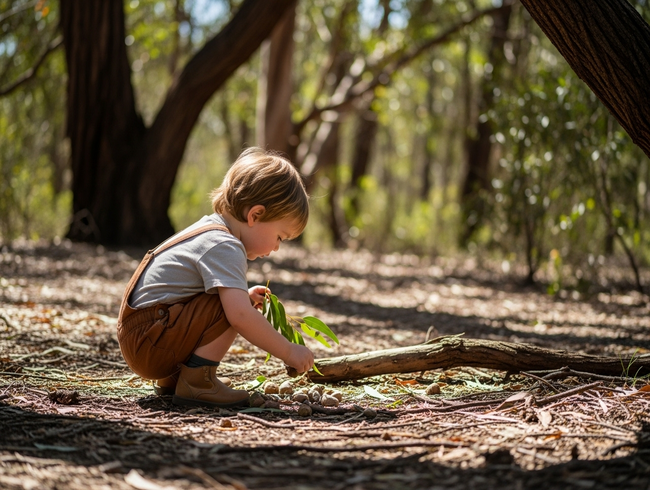
Our unique location beside Alex Forest Bushland Park provides endless natural storytelling opportunities.
Our Guiding Philosophy: Why Storytelling is Central to Quality Care
For parents navigating the world of early education, a common concern is whether a play-based program is rigorous enough. The answer lies in understanding that high-quality, evidence-based play is the most rigorous form of learning for young children.
Under the National Quality Standard (NQS) Quality Area 1: Educational Program and Practice, centres are required to provide a program that is play-based and fosters all areas of development. Storytelling is a cornerstone of how we meet and exceed this standard. It is not an afterthought or a ‘filler’ activity; it is an intentional, educator-led strategy that targets specific developmental outcomes in language, cognition, and emotional regulation.
Our program is a living embodiment of the Early Years Learning Framework’s vision of “belonging, being, and becoming.” Through shared stories, children feel a sense of belonging to a group. In the present moment of the tale, they are simply being—immersed and engaged. And with every story, they are becoming more capable communicators, more empathetic friends, and more imaginative thinkers.
When you choose a centre, you are choosing a partner in your child’s development. That partnership should be built on a shared understanding of not just what we do, but why we do it. The science is clear: the simple, loving act of sharing a story is one of the most significant investments you can make in your child’s future success and happiness.
We invite you to see this philosophy in action. To witness how our highly qualified educators use intentional, play-based practices like storytelling to create a nurturing environment where every child can soar.
Ready to see how purposeful play builds brilliant minds? We invite you to book a tour to experience our unique learning environments and see how our educators bring the Early Years Learning Framework to life. Contact Okinja Early Learning Centre & Kindergarten today on 07 5479 2222 or email admin@okinjaelc.com.au to discover how we can support your child’s journey.

Experience the Okinja difference. We invite you to book a tour of our unique indoor-outdoor learning environments.

